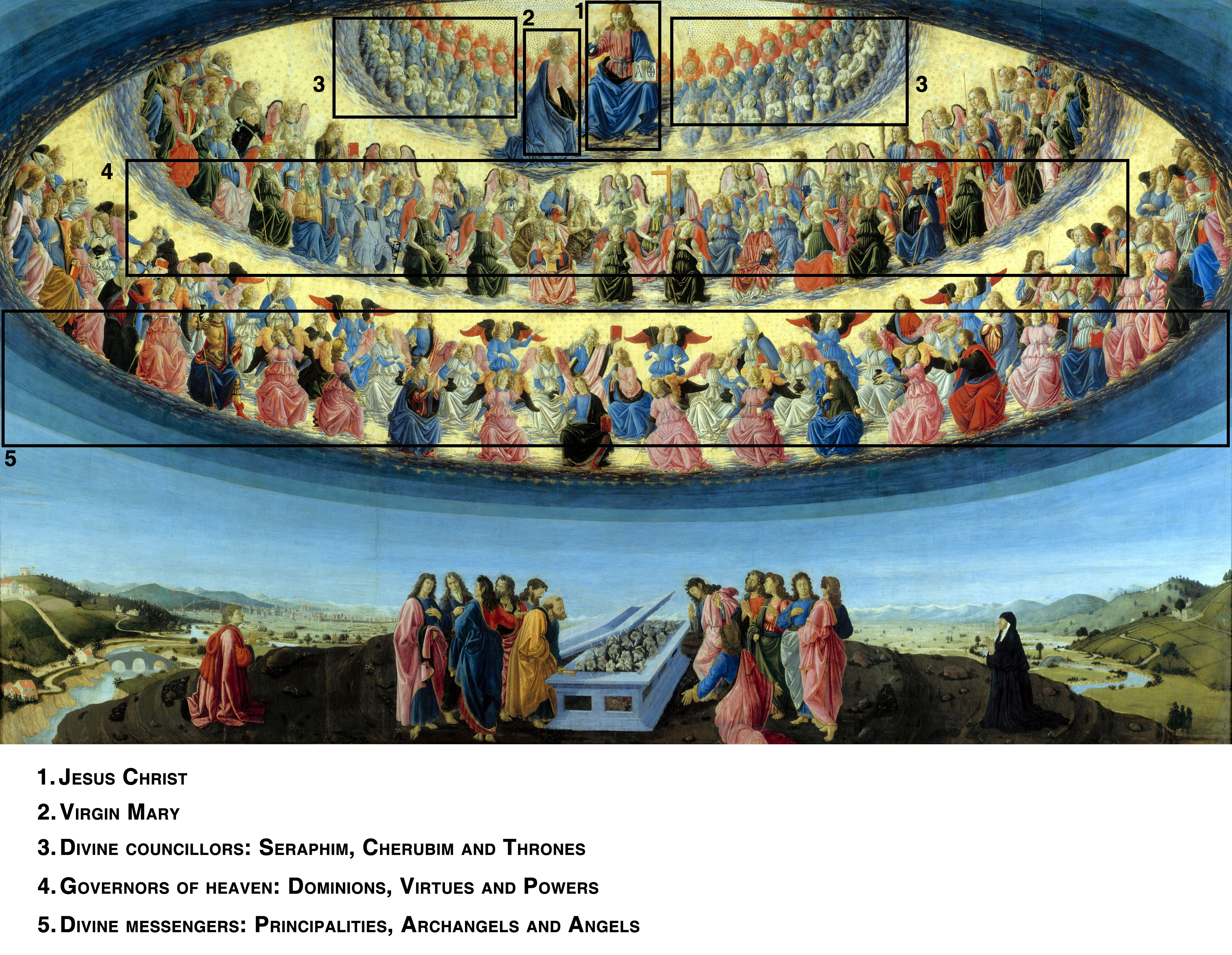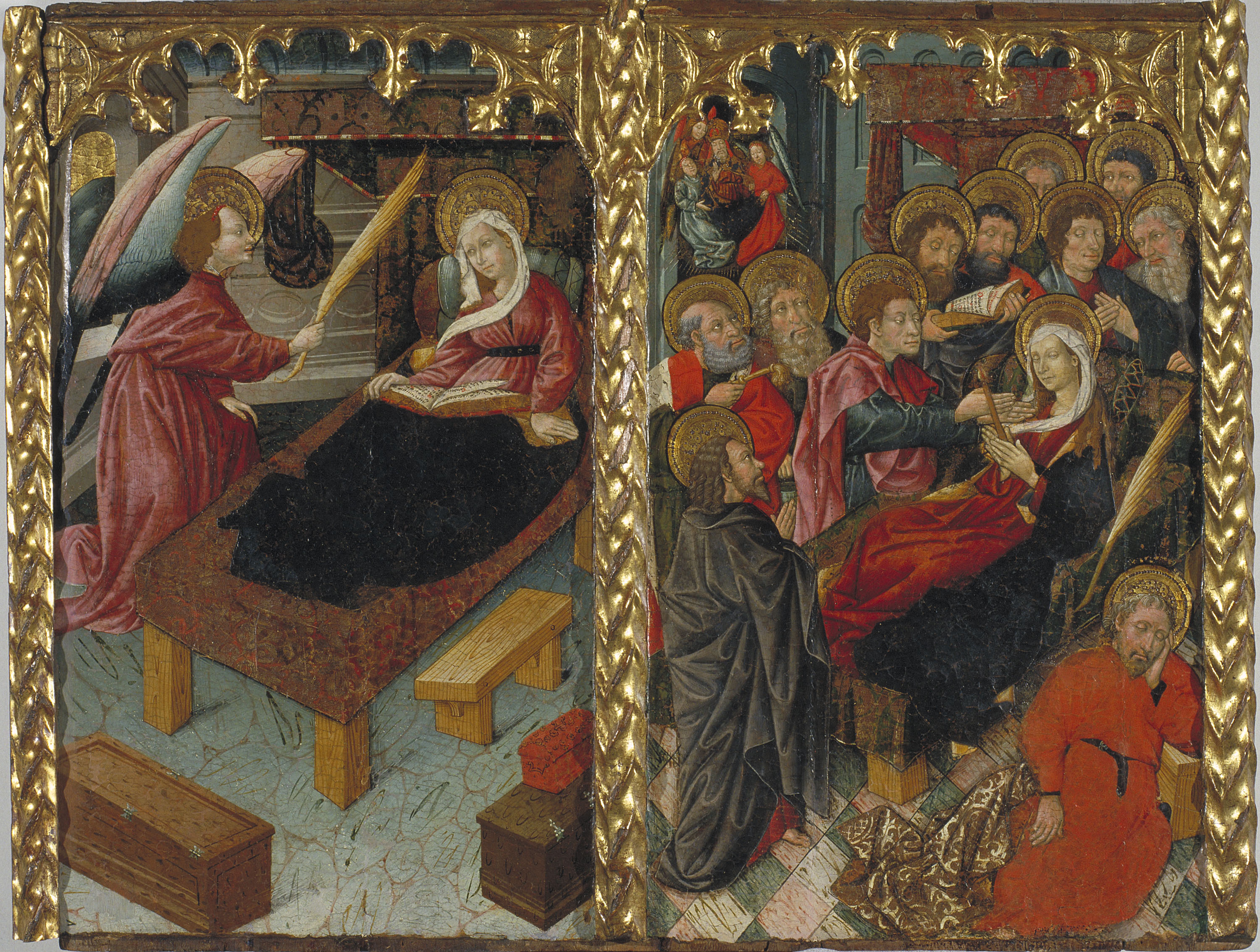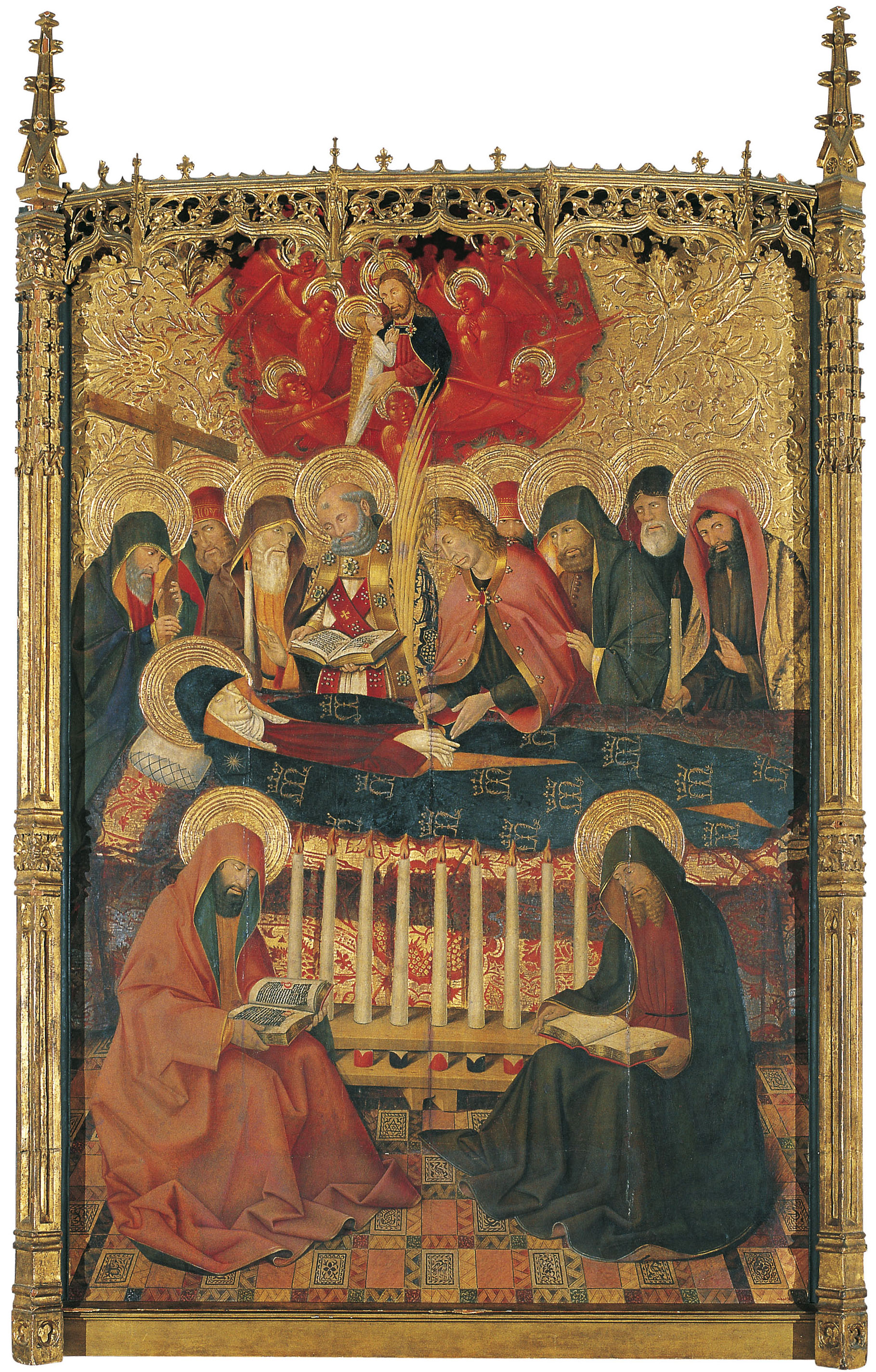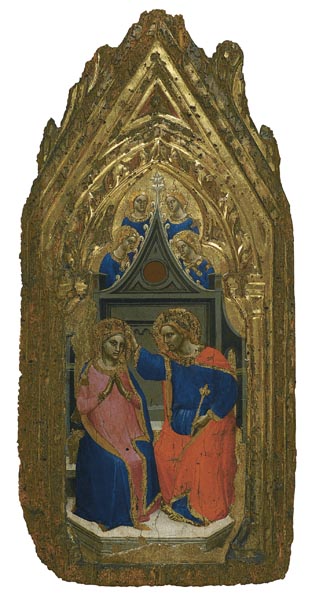Montse Gumà
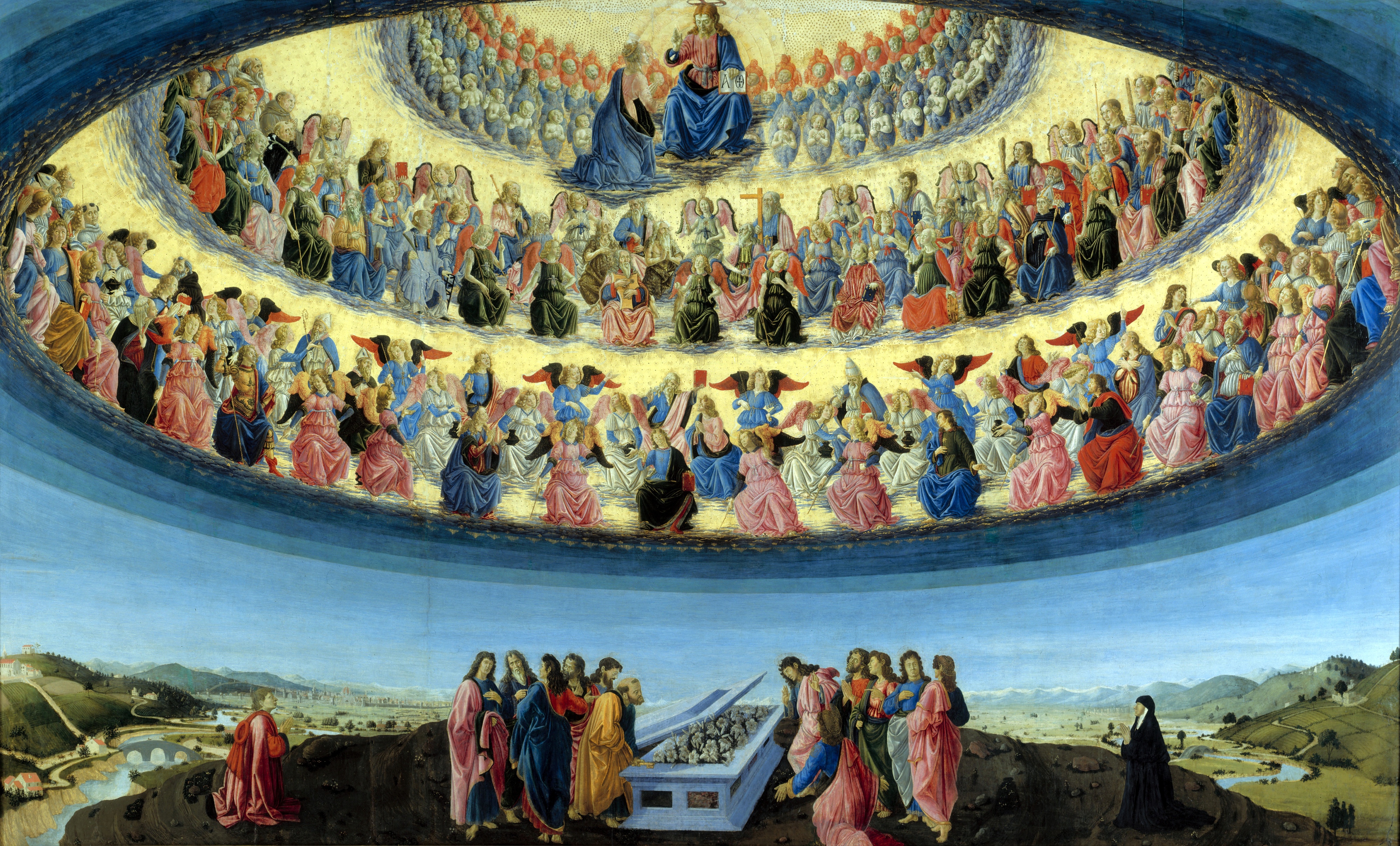
Francesco Botticini, The Assumption of the Virgin, probably about 1475-1476, National Gallery [public domain]
As Louis Réau tells us in Iconography of Christian Art, “God does not live alone in Paradise.” He is accompanied by his bodyguards and the militias, and the ministers that act as intermediaries between God and mankind and transmit His instructions. And who are these personages? The angels. But not all angels are the same, as we shall see below.
They are arranged in three orders, each divided into three choirs, and the Virgin Mary is their queen. Each choir has its functions and its own artistic depiction that I shall list in descending order of importance.
First hierarchy: divine councillors
- Seraphim: they are the caretakers of the throne of God, whom they praise. They have three pairs of wings with eyes, with which they protect themselves from God’s light. The combination of a seraph and an archangel appears in Santa Maria de Taüll, on one of the lateral intradoses of the arches that precede the apse. In this case the seraph, with the three pairs of wings, is flanked by two winged, anthropo-zoomorphic representations of the evangelists Mark and John, with the archangel Gabriel on the right as we look at it, identified by an inscription. Although it has been lost, the other two evangelists must have been shown on the other side accompanied by a cherub, as in Sant Climent de Taüll or in Santa Eulàlia d’Estaon.
The apse of Santa Eulàlia d’Estaon is presided over by the Maiestas Domini or Christ in Majesty, inside an almond-shaped mandorla, surrounded by the symbols of the evangelists. The most noticeable of them is John’s, with a human body and an eagle’s head. Luke’s ox and Mark’s lion emerge from the bottom of the mandorla in a centrifugal position. At the sides we see a cherub and a seraph, identified by inscriptions, and at the edges the archangels Michael and Gabriel, with signs that identify them as advocates. On the wall of the apse, we see the Baptism of Christ in the Jordan by John the Baptist, with an angel holding his clothes, as we can see in the following image.
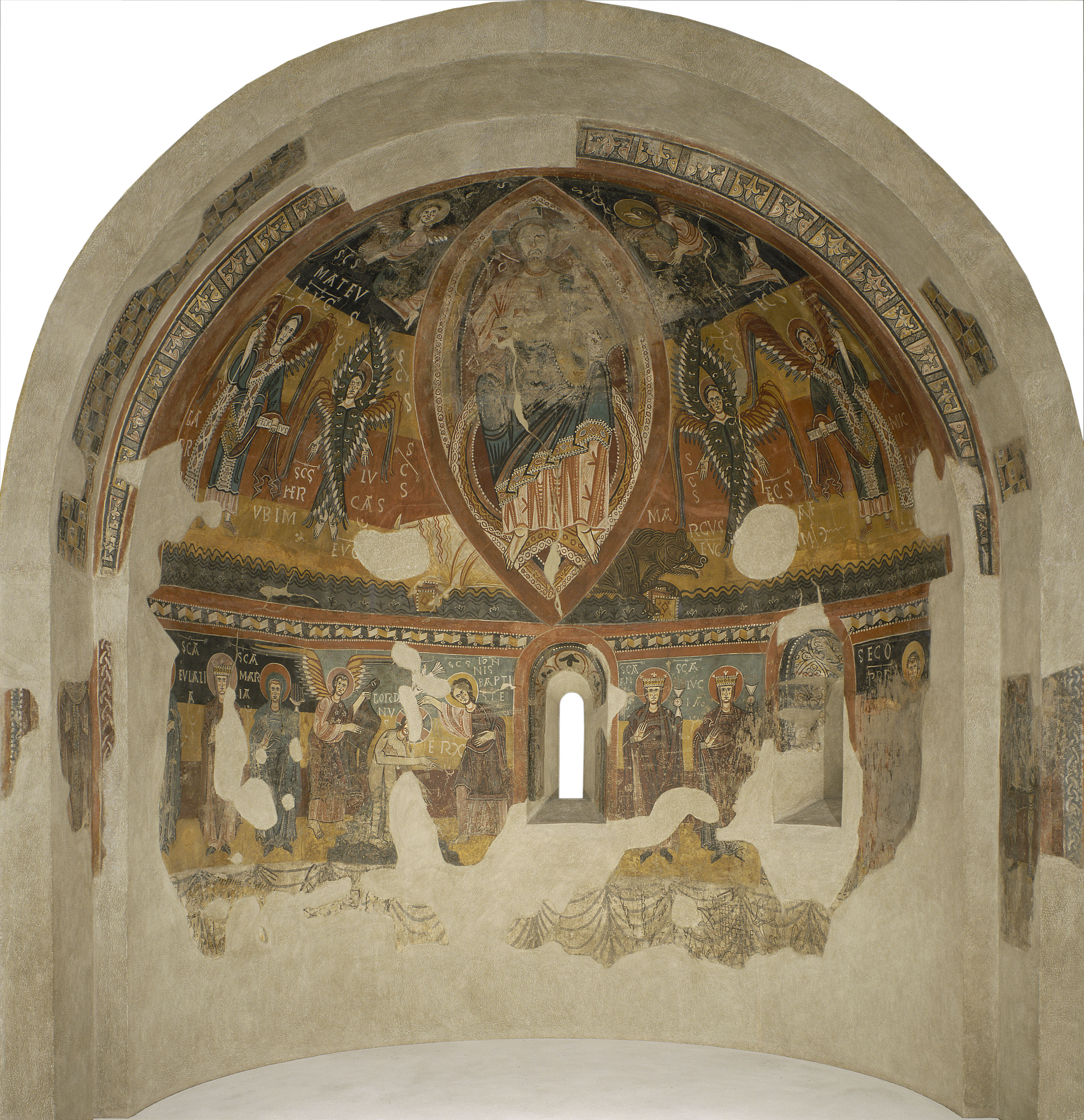
Apse of Estaon, mid 12th century
- Cherubim: they are the caretakers of the stars and the guardians of the light. They have two pairs of wings and, according to some traditions, four faces: ox, lion, man and eagle, the animals that were to become the symbols of the four evangelists. In the image below, the apse of Esterri de Cardós, on either side of the Tetramorph, a cherub and seraph appear, both identical, with the censer and their many-eyed wings; this means that God is all-seeing and all-knowing (omniscient). At the edges, arranged in a way that I have already commented upon in the previous examples and which we shall habitually see in other mural decorations, the archangel intercessors: Gabriel, on the right, and Michael, half erased, on the left.
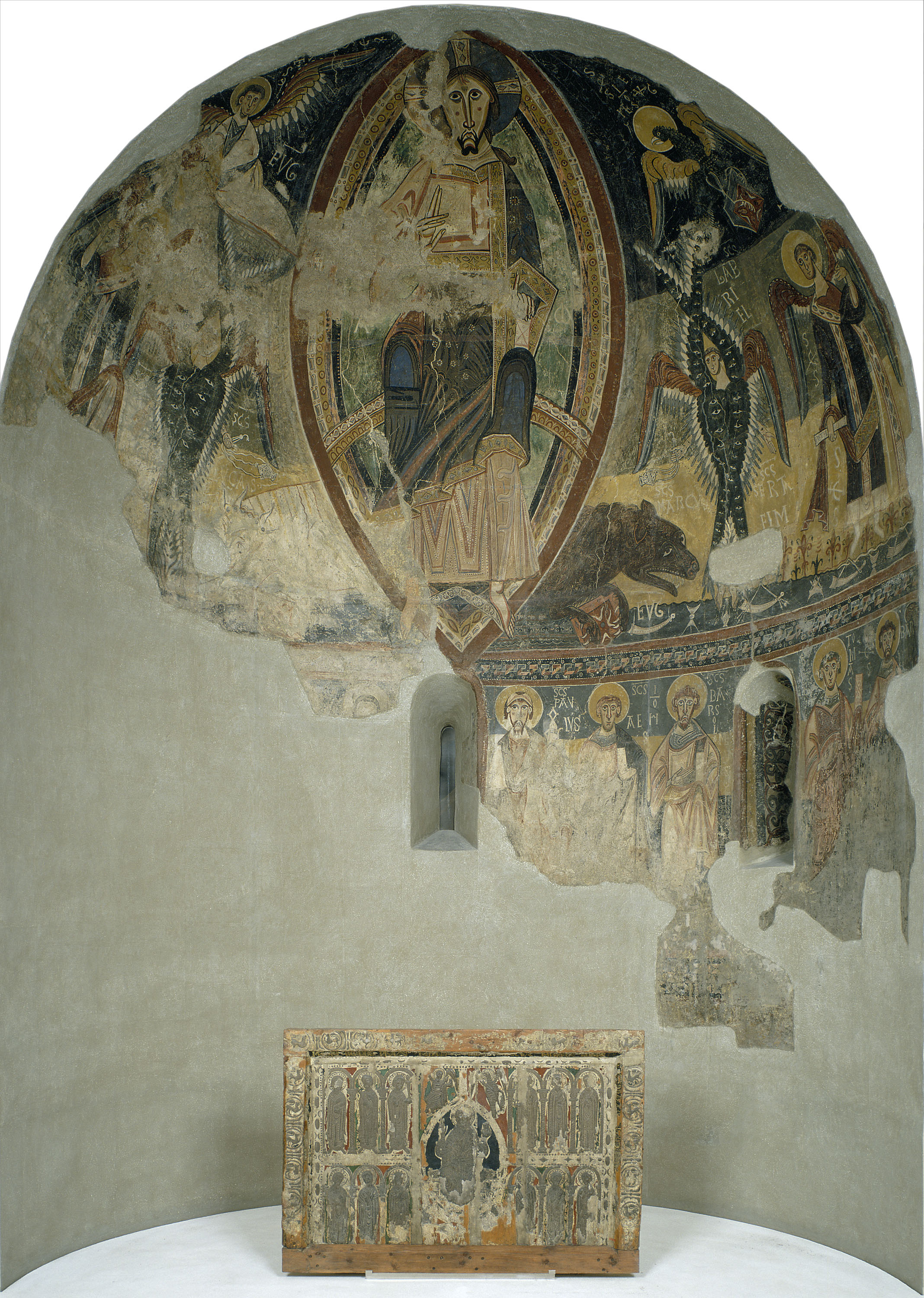
Apse of Esterri de Cardós, second half of the 12th century
- Thrones: they are in charge of keeping a register of mankind’s acts and they are the builders of universal order. They also carry the throne of God around Paradise. They are depicted as beings with round wings in the colours of the rainbow, as we can appreciate in the details of the painting from the apse of Santa Maria d’Àneu.

Detail of the Paintings from the apse of Santa Maria d’Àneu, late 11th-early 12th century
Second hierarchy: governors of heaven
- Dominions: they are charged with regulating the duties of the lesser angels and they are responsible for the universe being kept in order. They take orders from cherubim and seraphim and even from God. They do not manifest themselves directly to people. They bear a sceptre and wear a crown.
- Virtues: they are in charge of supervising people. They are shown in the form of beams of light that inspire people and they hold a book in their hand.
- Powers: their task is to safeguard conscience and history, and ideologies and intellectual questions. They oversee the distribution of powers among humans.
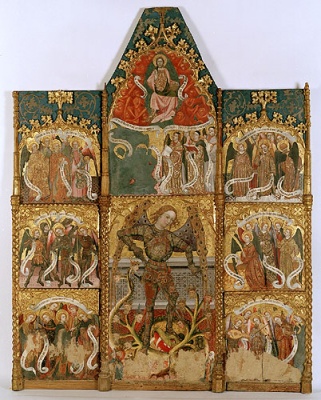
Attributed to Lluc Borrassà, Altarpiece of Saint Michael the Archangel, [depiction of the nine choirs of angels], around 1430-1450, Koninklijk Museum voor Schone Kunsten, Antwerp [public domain]
Third hierarchy: divine messengers
- Principalities: they are the guardians of nations and they oversee their political, commercial and military affairs. They are dressed as warriors or deacons holding lilies in their hands.
- Archangels: they are the princes and the leaders of the angels. They influence the great human events. They are the only ones whose names we know. In the decoration of the Apse of Santa Maria d’Àneu, two seraphim with three pairs of wings appear in the lower register, singing “S(AN)C(TU)S S(AN)C(TU)S S(AN)C(TU)S” in praise of God. Notice also the prominence of the three archangels, Michael, Gabriel and Raphael, advocates of the Day of Judgment. As we can see in the image below, Michael appears on the left of the apse ceiling and Gabriel, on the right. Raphael, on the other hand, is shown next to the seraphim, in the middle register. The pair of burning wheels, associated with Ezekiel’s prophetic vision, can be associated with the thrones, as we saw earlier.
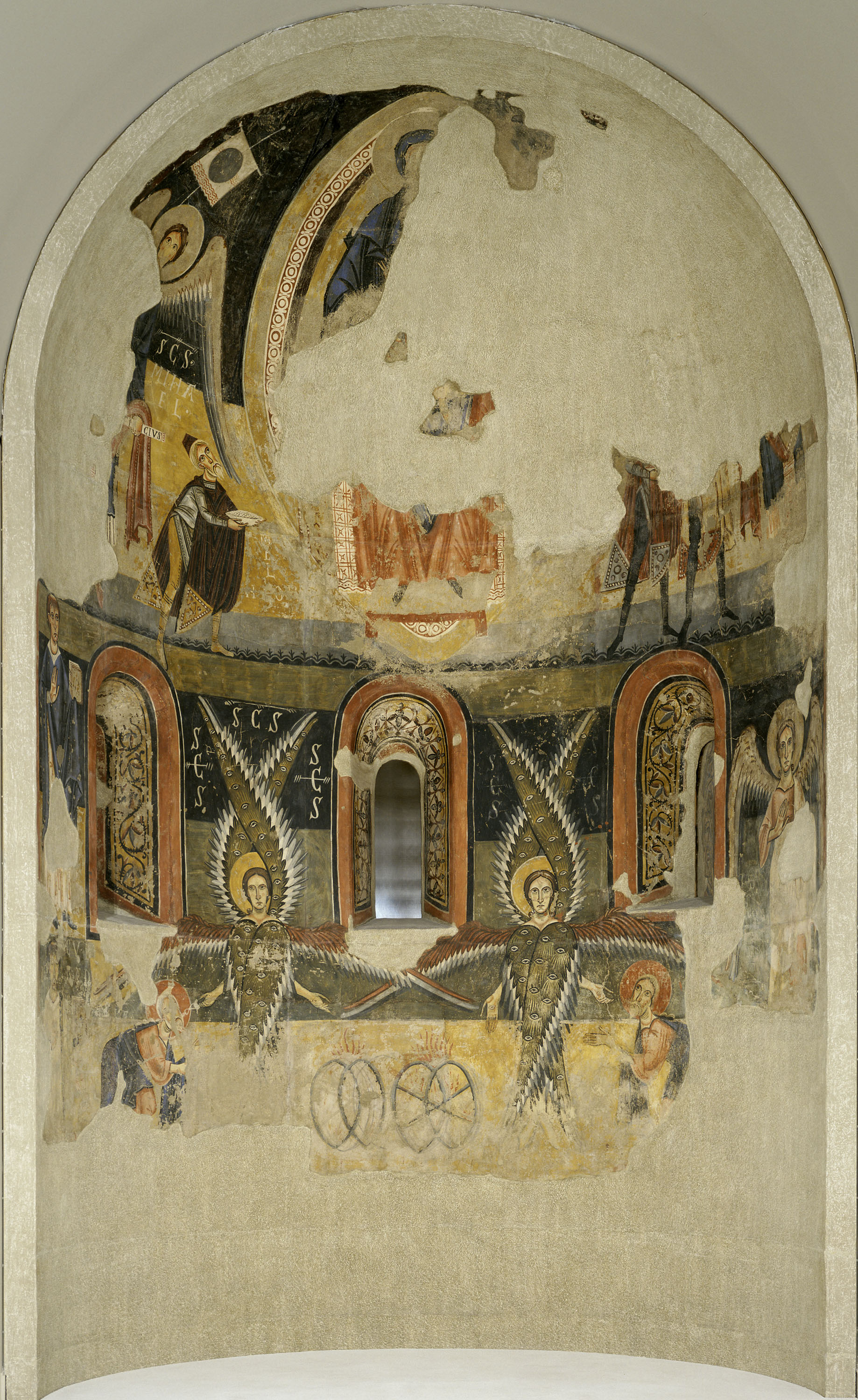
Paintings from the apse of Santa Maria d’Àneu, late 11th – early 12th century
- Angels: they are the lowest order of the angelical hierarchy, but the most familiar to people, because they are God’s messengers on Earth. They are the soldiers of the army and they hold censers or torches. The Christ in Majesty inside the mandorla in the Apse of Sant Climent de Taüll appears surrounded by angels who present or hold the symbols of the evangelists, to show their celestial nature, a role given to them in many other examples. Completing the scene are two symmetrical images that symbolize a seraph and a cherub, with the habitual many-eyed wings.
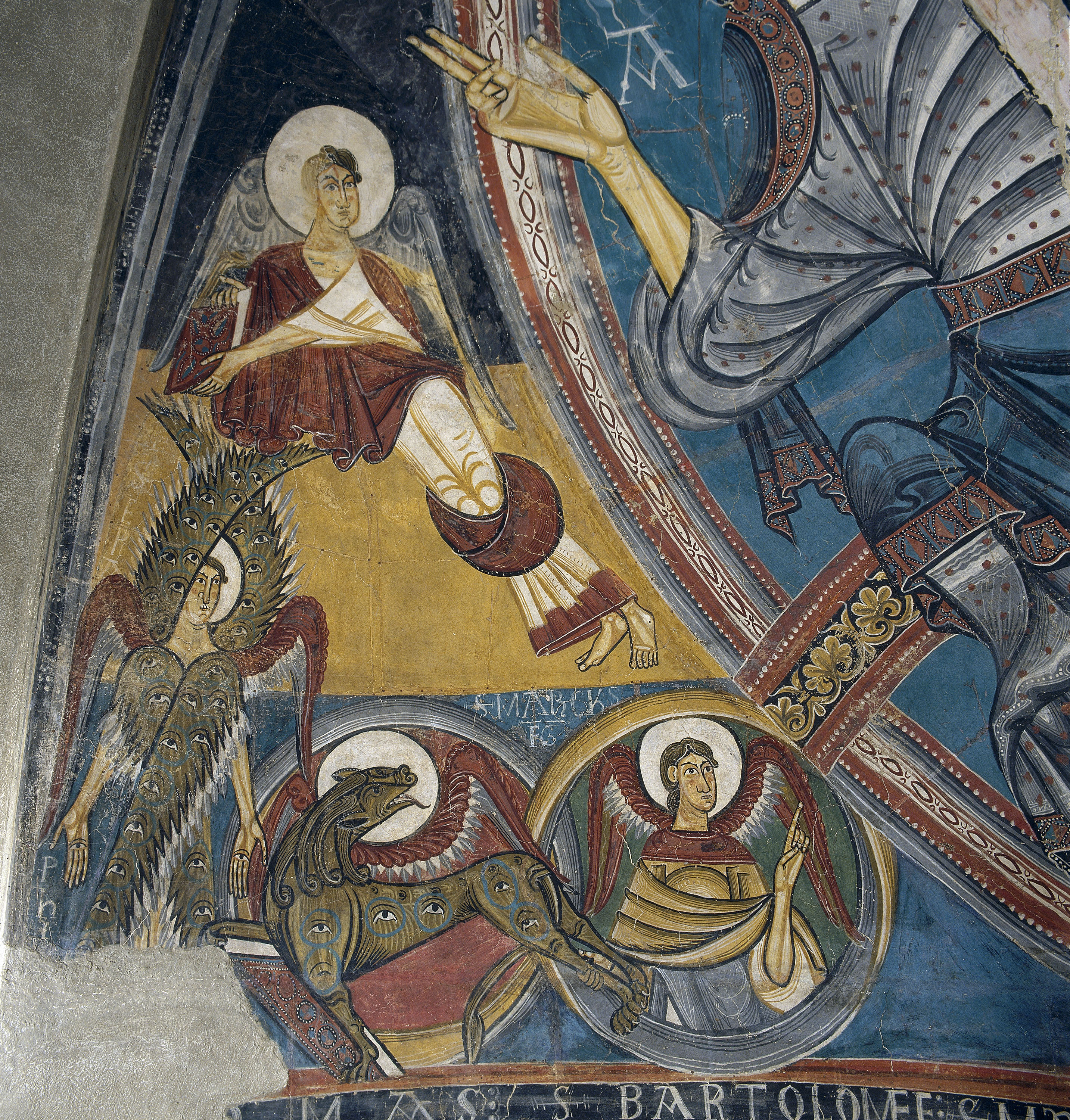
Detail of the Apse of Sant Climent de Taüll, about 1123
According to the Gospel of Saint Luke, it is also an angel that announces the birth of a child, the future Saviour, to the shepherds. An angel-star, this time according to the Gospel of Saint Matthew, guides the Magi to the stable in order to show them the newborn baby. And an angel warns them, while they are asleep, that they must return home by a different route if they wish to save their lives.

Isidre Nonell, L’Anunciata (The Annunciation), 1896
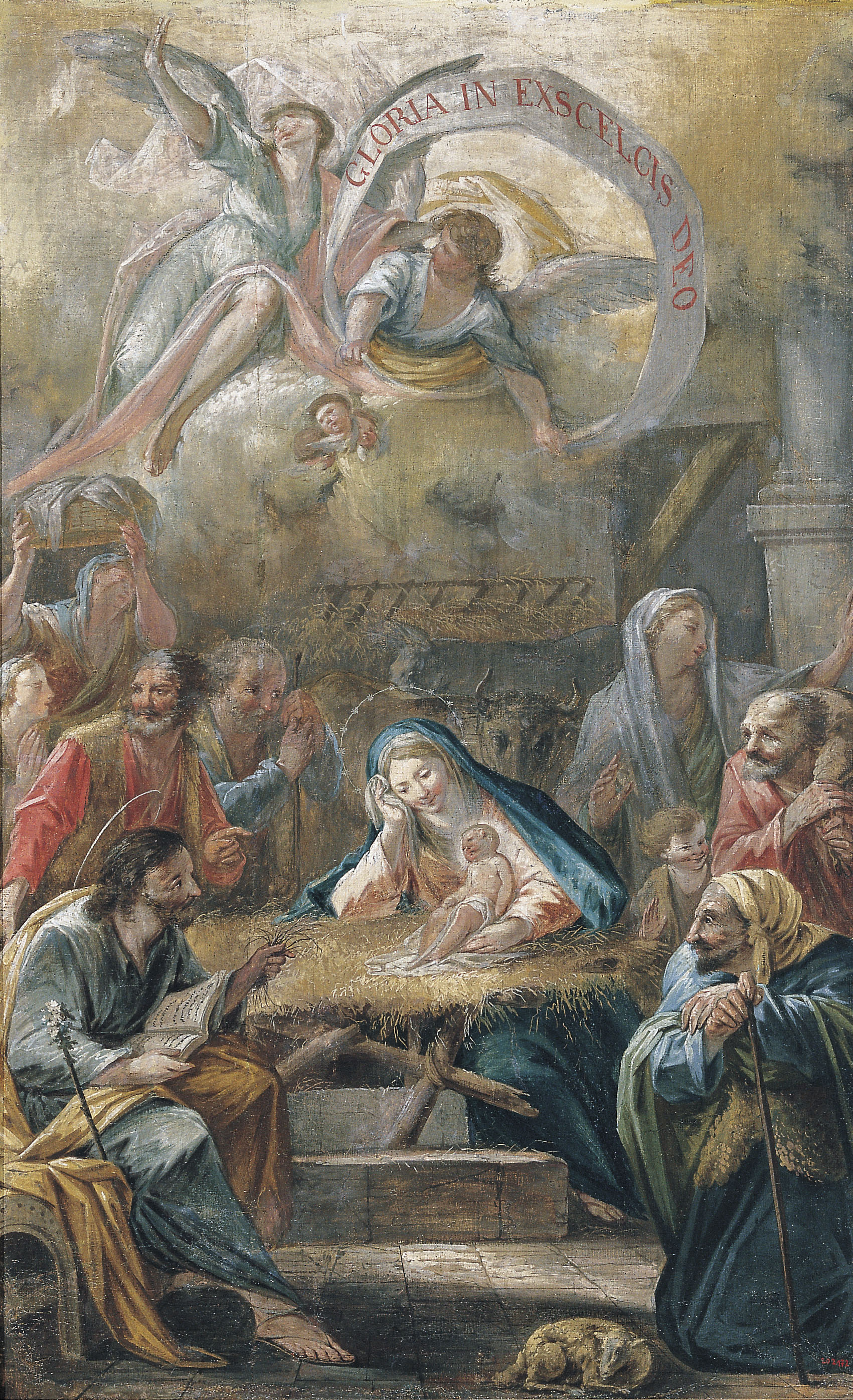
Francesc Pla (el Vigatà), The Birth of Jesus and the Adoration of the Shepherds, about 1780
Gradually, the angels multiply and eventually become a group of angel musicians that sing Gloria in excelcis Deo to the infant. Or, as on the panel of the Virgin of the “Consellers”, the song of songs, Tota pulcra es, amica mea, et macula non est in te, in a clear allusion to the Immaculate Conception of Mary.
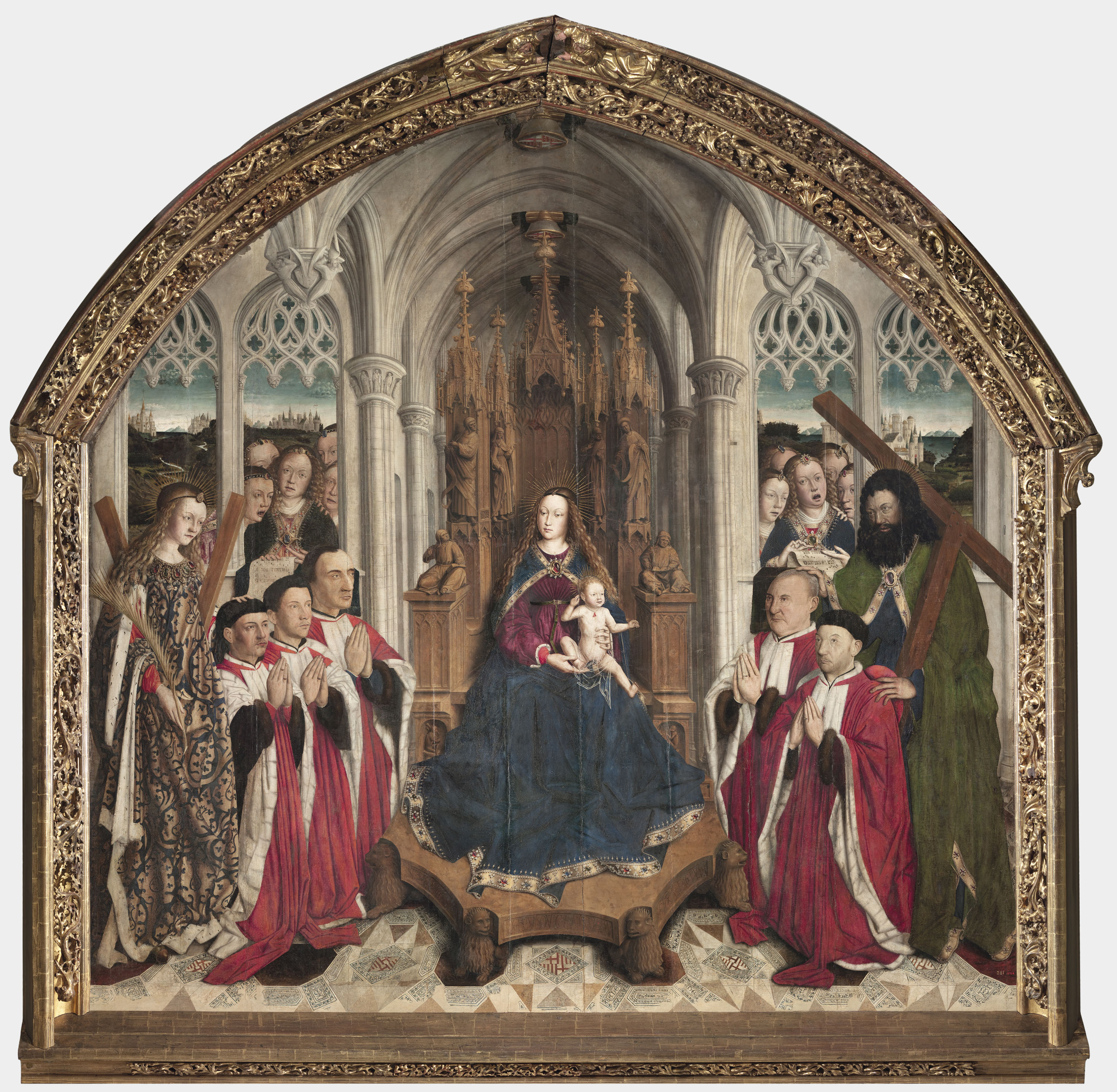
Lluís Dalmau, Virgin of the “Consellers”, 1443-1445
Also associated with the figure of Mary, we find them announcing her death, or in the scenes of the Dormition and the Coronation of the Virgin Mary.
In another post, we shall look at the principal archangels: Saints Michael, Gabriel and Raphael, a legendary iconography.
Related references:
Pseudo-Dionysius the Areopagite, La jerarquia celestial. La jerarquia eclesiàstica (On the Celestial and Ecclesiastical Hierarchies), Barcelona, 1994
Projectes digitals

